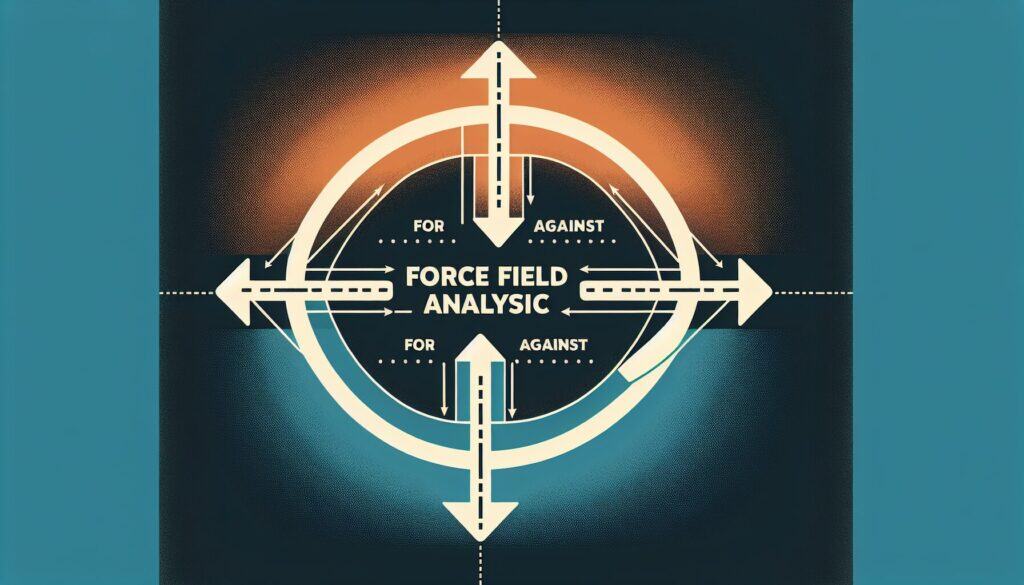Analizzare le forze favorevoli e contrarie a un cambiamento proposto.
- Metodologie: Ingegneria, Qualità
Analisi del campo di forza

Analisi del campo di forza
- Gestione del cambiamento, Miglioramento continuo, Miglioramento dei processi, Gestione del progetto, Gestione della qualità, Gestione del rischio, Analisi SWOT, Lavoro di squadra
Obiettivo:
Come si usa:
- Strumento decisionale che prevede l'identificazione delle forze trainanti (fattori che sostengono il cambiamento) e delle forze frenanti (fattori che si oppongono al cambiamento). A ogni forza viene tipicamente assegnato un punteggio e l'analisi aiuta a strategizzare il rafforzamento delle forze trainanti e l'indebolimento delle forze frenanti.
Professionisti
- Fornisce una chiara sintesi visiva dei fattori che influenzano un cambiamento; aiuta a comprendere le complessità di un'iniziativa di cambiamento; facilita la discussione e la creazione di consenso; aiuta a sviluppare strategie per gestire il cambiamento in modo efficace.
Contro
- Può essere soggettivo nell'identificare e attribuire un punteggio alle forze; può semplificare eccessivamente situazioni complesse; non fornisce una soluzione definitiva, ma solo un quadro di analisi; il processo di quantificazione delle forze qualitative può essere impegnativo.
Categorie:
- Risorse umane, Risoluzione dei problemi, Gestione del progetto
Ideale per:
- Prendere decisioni su un cambiamento proposto identificando e valutando sistematicamente i fattori che lo sosterranno o lo ostacoleranno.
Force Field Analysis is widely applied across various sectors such as healthcare, education, manufacturing, and software development during the planning and implementation phases of projects that involve change initiatives. This methodology is typically initiated by project managers, change agents, or team leaders who seek to drive significant modifications, like the introduction of new technologies or reforms in organizational policies. It is valuable during the early stages of projects when understanding stakeholder perceptions is essential for success or when conducting impact assessments related to potential changes. Participants in these discussions often include cross-functional teams comprising engineers, designers, business analysts, and end-users, ensuring diverse perspectives are represented. By quantifying driving and restraining forces, teams can visualize the balance of power influencing the change process, which aids in facilitating open dialogue for consensus-building. For example, in an engineering context, Force Field Analysis may be employed during the design phase of a new product to weigh the benefits of cutting-edge materials against potential production challenges, enabling more informed decision-making. Furthermore, it supports strategic planning by allowing organizations to formulate actionable steps to bolster supportive factors while mitigating resistance, thus increasing the likelihood of successful implementation within a structured gestione del cambiamento framework.
Fasi chiave di questa metodologia
- Clearly define the change initiative or decision to be analyzed.
- Identify and list all driving forces supporting the change.
- Identify and list all restraining forces opposing the change.
- Assign scores to each driving and restraining force according to their impact.
- Create a visual representation of the driving and restraining forces.
- Analyze the balance of forces to understand potential outcomes.
- Develop strategies to strengthen driving forces and mitigate restraining forces.
- Implement the strategies and monitor the effects on driving and restraining forces.
Suggerimenti per i professionisti
- Incorporate stakeholder feedback throughout the Force Field Analysis process to refine the understanding of driving and restraining forces.
- Use a scoring system that quantifies the strength of each force, enabling data-driven discussions about prioritization and strategy development.
- Regularly revisit and update the Force Field Analysis to adapt to changing internal and external factors that may influence the change initiative.
Leggere e confrontare diverse metodologie, raccomandiamo il
> Ampio archivio di metodologie <
insieme ad altre 400 metodologie.
I vostri commenti su questa metodologia o ulteriori informazioni sono benvenuti su sezione commenti qui sotto ↓ , così come tutte le idee o i link relativi all'ingegneria.
Contesto storico
1902
1907
1915
1915-11
1918
1920
1922
1902
1904
1913
1915
1916
1919-05-29
1920
1924
(se la data non è nota o non è rilevante, ad esempio "meccanica dei fluidi", viene fornita una stima approssimativa della sua notevole comparsa)















Post correlati
Programma di produzione principale (MPS)
Personalizzazione di massa
Imbuto di marketing
Audit di marketing
Indice MAPO (Movimento e assistenza dei pazienti in ospedale)
Pianificazione delle risorse di produzione (MRP II)